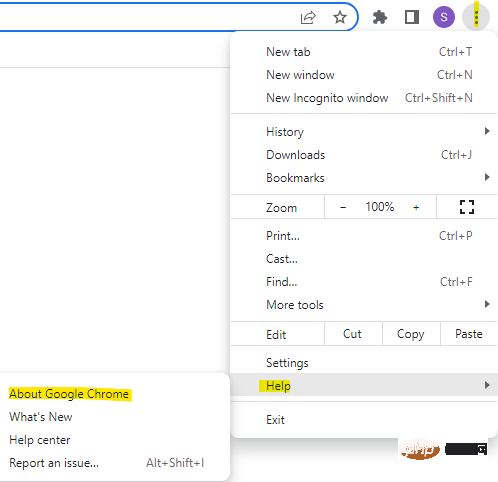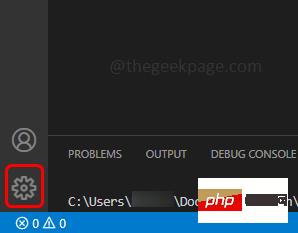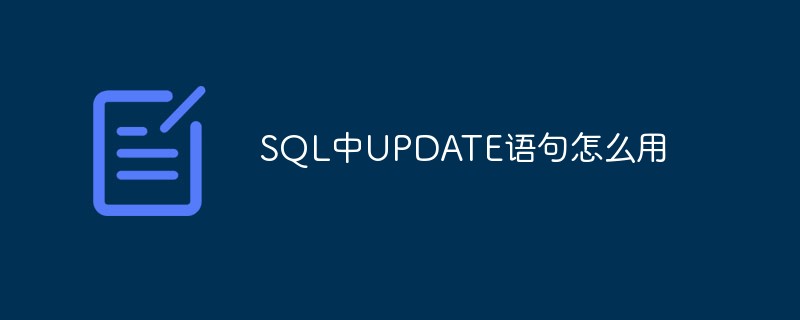As mentioned before, the setting up environment of MySQL and how to use select to query data in MySQL. Next, based on the experience in this section, I will briefly explain how to update data in MySQL. If you want to update it, of data.
In MySQL, use the update keyword to update data.
1. First of all, let’s briefly describe why there is an update function. For example, we all have Space has a function called posting articles. If there is no update function, it will result in that your article can never be modified after it is submitted and saved. You said that I can save 100% correct articles when I write them. But , what if you want to change? So, there is the keyword update.

2. Let’s look at the first case first. Here we only explain the case and do not analyze the principle. First we We need to be clear about what we do. We want to update data, so we need to use the syntax structure of update. Before this step, we need to write about the current environment changes. First, you need to have a library, a table, and There is data, but there is no data. How can you update the data you want to update? Then if there is a database, tables and data, you can operate on the numbers.


3. Do the first operation: update the content of content to content. Here, it is a simple modification, and then modify the data in all the content fields in the table. The fields will be changed to the value of content. Modify it to content. This is the simplest case of updating data. However, this is generally not practical. During the development process, I rarely use this situation. Because some tables have not one or two pieces of data, it may be Millions of data. Just update it and it will make you cry.
The first picture is to query the data and then perform the update. Then you will find that the values of all the content fields in the table are It has become content.


4. What if we don’t update all of them? We just want to update certain pieces of data, can we not? Can it be done? The answer is definitely yes. Here update can also use filter conditions like select, that is, use the keyword where. For example, we want to change the data content of id = 1 to, 'This is the content of id1'

5. When updating, especially under the console, sometimes you will find that you have already updated, and after the update , query, but if you cannot query the updated content during development, it may be because you did not commit. When changing the content in the table, there is the concept of things. That is, you do not commit ( commit) what you have done, others cannot see your updated content.

#6. Here is only the operation method of a single table. In the update You can also perform multi-table operations. In the process of making mistakes, you must find the corresponding relationship, otherwise you will have unexpected errors in modifying the data.

Notes
Nothing can be remembered by just reading an article at the beginning, so while forcing yourself to remember, you can also pay attention to the methods of learning and practicing.
Play while learning, play Middle school. Learning programming is a good way. Gook lunk!!!!
The above is the detailed content of How to learn MySQL? Use of update in MySQL and MySQL update. For more information, please follow other related articles on the PHP Chinese website!
 修复:谷歌浏览器更新检查失败错误代码3:0x80040154Apr 13, 2023 pm 05:46 PM
修复:谷歌浏览器更新检查失败错误代码3:0x80040154Apr 13, 2023 pm 05:46 PM谷歌浏览器是全球最受欢迎的浏览器之一,许多用户更喜欢将其用作 Windows PC 上的默认浏览器。Chrome 提供了广泛的功能,使浏览体验愉快而轻松,因此,它仍然是最受信任的浏览器之一。但是,就像任何其他浏览器一样,即使 Chrome 也有其自身的缺点,它同样容易在您最需要的时候出现错误和故障。一个这样的错误是错误代码 3:0x80040154,这发生在检查 Google Chrome 更新时。错误消息显示为“检查更新时发生错误。更新检查无法启动(错误代码 3:0x80080005)或(错误
 如何启用/禁用 VS Code 自动更新Apr 28, 2023 am 09:28 AM
如何启用/禁用 VS Code 自动更新Apr 28, 2023 am 09:28 AM如果您正在使用VisualStudioCode(VSCode)并考虑如何禁用它的自动软件更新以及如何禁用其扩展的自动更新,那么请阅读本文。如果你不经常使用VSCode,隔了很长一段时间打开编辑器并想启用自动更新,本文也将指导你这样做。让我们详细讨论启用或禁用VSCode自动更新的不同方法。目录方法一:使用设置启用/禁用VSCode自动更新第一步:打开VS代码,在左下角点击齿轮状的符号。第2步:在出现的列表中单击设置。第3步:在搜索栏中输入更新并回车。查找更新:模式第4
 mysql怎么替换换行符Apr 18, 2022 pm 03:14 PM
mysql怎么替换换行符Apr 18, 2022 pm 03:14 PM在mysql中,可以利用char()和REPLACE()函数来替换换行符;REPLACE()函数可以用新字符串替换列中的换行符,而换行符可使用“char(13)”来表示,语法为“replace(字段名,char(13),'新字符串') ”。
 KDE Plasma 6.1 brings many enhancements to the popular Linux desktopJun 23, 2024 am 07:54 AM
KDE Plasma 6.1 brings many enhancements to the popular Linux desktopJun 23, 2024 am 07:54 AMAfter several pre-releases, the KDE Plasma development team unveiled version 6.0 of its desktop environment for Linux and BSD systems on 28 February, using the Qt6 framework for the first time. KDE Plasma 6.1 now comes with a number of new features t
 Microsoft compatibility telemetry占用高CPU的解决方法Mar 16, 2024 pm 10:16 PM
Microsoft compatibility telemetry占用高CPU的解决方法Mar 16, 2024 pm 10:16 PM我们在使用win10系统的时候有时候会遇到电脑变得卡顿的情况,然后我们在查看后台进程的时候会发现一个Microsoftcompatibilitytelemetry的进程占用资源特别的高,那么这是怎么回事?用户们可以尝试卸载三方防护软件后尝试干净启动来进行操作,下面就让本站来为用户们来仔细的介绍一下Microsoftcompatibilitytelemetry占用高CPU的解决方法吧。Microsoftcompatibilitytelemetry占用高CPU的解决方法方法一:卸载三方防护软件后尝试
 MySQL复制技术之异步复制和半同步复制Apr 25, 2022 pm 07:21 PM
MySQL复制技术之异步复制和半同步复制Apr 25, 2022 pm 07:21 PM本篇文章给大家带来了关于mysql的相关知识,其中主要介绍了关于MySQL复制技术的相关问题,包括了异步复制、半同步复制等等内容,下面一起来看一下,希望对大家有帮助。
 SQL中UPDATE语句怎么用Jun 02, 2023 pm 09:13 PM
SQL中UPDATE语句怎么用Jun 02, 2023 pm 09:13 PMSQLUPDATE语句Update语句用于修改表中的数据。语法如下:UPDATE表名称SET列名称=新值WHERE列名称=某值"Person"表:LastNameFirstNameAddressCityGatesBillXuanwumen10BeijingWilsonChamps-Elysees更新某一行中的一个列UPDATEPersonSETFirstName="Fred"WHERELastName="Wilson"结果:LastNa
 Fitbit Ace LTE receives major update with new games, contactless payment and other featuresAug 08, 2024 pm 09:39 PM
Fitbit Ace LTE receives major update with new games, contactless payment and other featuresAug 08, 2024 pm 09:39 PMThe Fitbit Ace LTE was officially launched in May, but is currently only available in the US. The smartwatch is aimed specifically at children, who can receive rewards for games through a more active lifestyle, while parents can always monitor their


Hot AI Tools

Undresser.AI Undress
AI-powered app for creating realistic nude photos

AI Clothes Remover
Online AI tool for removing clothes from photos.

Undress AI Tool
Undress images for free

Clothoff.io
AI clothes remover

AI Hentai Generator
Generate AI Hentai for free.

Hot Article

Hot Tools

mPDF
mPDF is a PHP library that can generate PDF files from UTF-8 encoded HTML. The original author, Ian Back, wrote mPDF to output PDF files "on the fly" from his website and handle different languages. It is slower than original scripts like HTML2FPDF and produces larger files when using Unicode fonts, but supports CSS styles etc. and has a lot of enhancements. Supports almost all languages, including RTL (Arabic and Hebrew) and CJK (Chinese, Japanese and Korean). Supports nested block-level elements (such as P, DIV),

ZendStudio 13.5.1 Mac
Powerful PHP integrated development environment

Zend Studio 13.0.1
Powerful PHP integrated development environment

SublimeText3 Chinese version
Chinese version, very easy to use

Safe Exam Browser
Safe Exam Browser is a secure browser environment for taking online exams securely. This software turns any computer into a secure workstation. It controls access to any utility and prevents students from using unauthorized resources.






